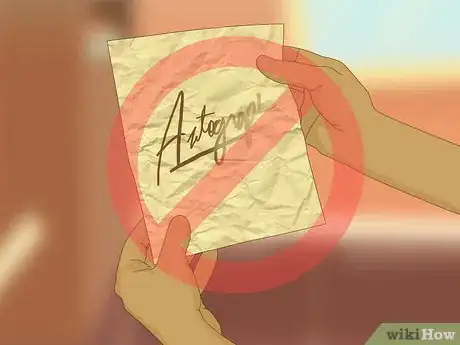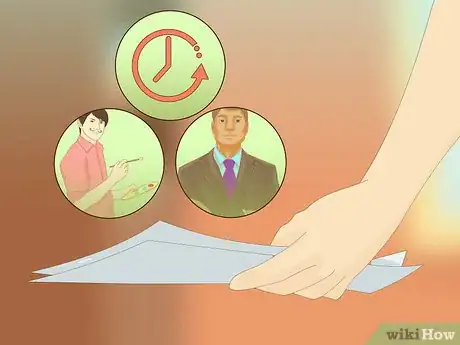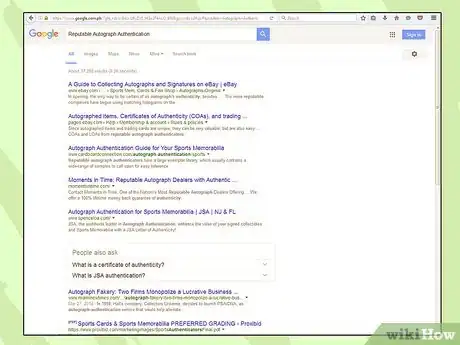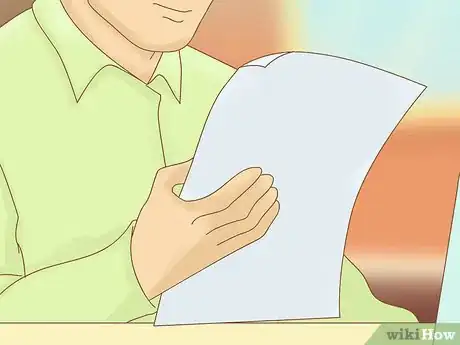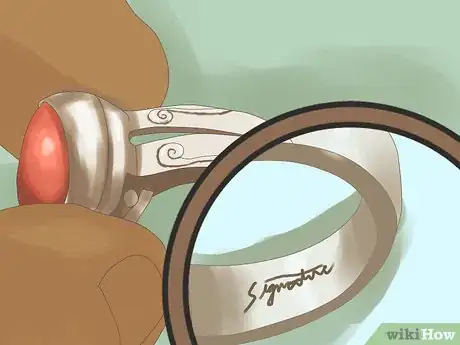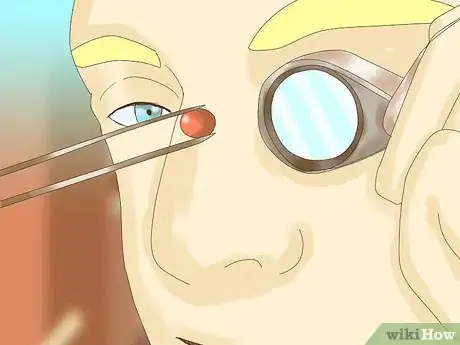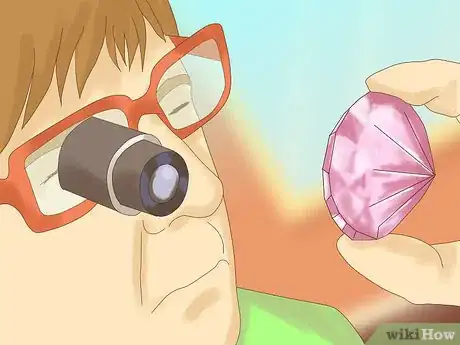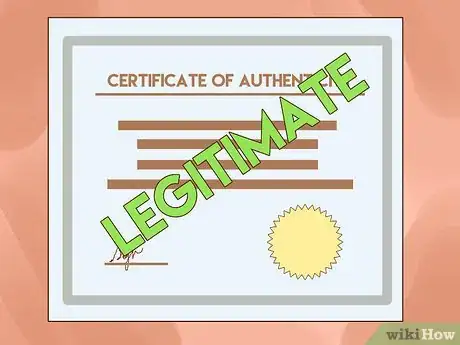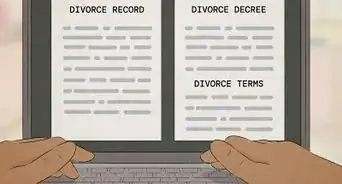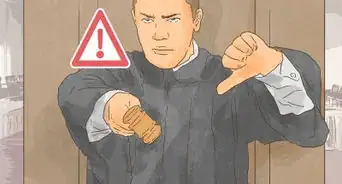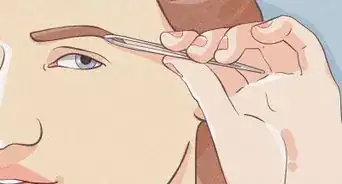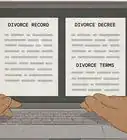This article was co-authored by wikiHow Staff. Our trained team of editors and researchers validate articles for accuracy and comprehensiveness. wikiHow's Content Management Team carefully monitors the work from our editorial staff to ensure that each article is backed by trusted research and meets our high quality standards.
There are 7 references cited in this article, which can be found at the bottom of the page.
This article has been viewed 151,803 times.
Learn more...
A certificate of authenticity is important for things like jewelry, artwork, and autographs. This is a slip of paper certifying your object is authentic, and not a forgery or fake. You will need to contact a professional authenticator in your given field in order to receive your certificate. You may have to gather some evidence to prove your item is legitimate. While the process can be somewhat of a headache, it will be worth it. You will be more easily able to sell your item if you have proof of its legitimacy.
Steps
Authenticating an Autograph
-
1Find an autograph authentication company. Autograph authentication companies can help you verify an autograph was legitimate. They use a combination of specialized autograph authentication equipment, as well as handwriting analysis and computer technology, to ascertain if an autograph is legitimate. If you obtained an autograph secondhand, this can be particularly helpful. If you intend to sell an autograph you obtained in person, this can also be helpful as potential buyers will know your autograph is real.[1]
- The most recognizable authentication companies include Professional Sports Authenticator (PSA), James Spence Authentication (JSA), and Autograph Certification Experts (ACE).
- It's a good idea to go with one of these companies, as you want a recognizable company to authenticate your autograph. However, if there's an authentication company in your area, it may be less of a hassle to work with a local company.
-
2Work with your company to have a professional determine the autograph's authenticity. Once you've selected an authentication company, you can begin the authentication process. If you live close by to an authentication company, you can go in and talk to someone in person. You usually have to work with a company from a distance, however, and must mail in autographs or autographed items.[2] [3]
- Any organization you're working with will have different requirements. There are usually a number of forms you must fill out that require basic contact information as well as information on where you obtained your item. Many authenticators have specific guidelines for how items should be packaged as well.
- Most authentication companies charge a fee for evaluation, and may charge additional fees to issue you a certificate of authenticity. For example, JSA charges fees that range from $35 to $50 depending on the type of autograph you send. You are also generally responsible for all shipping fees.
Advertisement -
3Receive your certificate of authenticity. Once your item has been evaluated, the authentication company will instruct you on how to receive a certificate of authenticity. There may be additional fees for certificates. Some companies, like PSA, grade autographs on a scale of 1 to 10. These grades determine how well an autograph has withstood the test of time, so keep in mind a very old autograph may receive a lower grade from some authenticators.[4]
-
4Avoid attempting to authenticate faded or illegible autographs. It's not always worth it to get a certificate of authenticity. Faded or messy autographs are difficult to authenticate, and the process may be more trouble than it's worth.[5]
- On occasion, an autograph you obtain in person may be rejected by an authentication company if the handwriting is messy or the paper is crinkled or faded. Illegible or fading autographs are hard to authenticate, and the process can be costly.
- Even if you can get a certificate verifying your autograph is authentic, a company may give you a low grade, potentially making the autograph difficult to sell. You may be better off keeping faded autographs for your own pleasure rather than attempting to authenticate and sell them.
Getting a Certificate of Authenticity for a Piece of Art
-
1Gather materials to prove your item is authentic. If you want to authenticate a work of art, you need to prove to an authenticator your work is legitimate. You will need to show where you obtained your work, its history, and previous owners.
- When you obtain a piece of art, hold onto any paperwork related to that item. For example, hold onto to receipts and bills of sale. If you purchased a piece of artwork through a well known and respected art dealer, its more likely to be authentic.
- You should also obtain paperwork that can prove a piece is legitimate. This can include magazine articles on the item, the names of previous owners, and an artist's catalogue featuring the piece.
-
2Find a reputable authenticator. You do not want to have your artwork authenticated by just anyone. It's important you find a legitimate authenticator. As you begin searching for authenticators in your area, watch for signs the people you find are legitimate.
- You can start your search with a simple Google search. You can also ask at museums and art departments at universities. Workers or professors at these places may have experience with art authentication.
- Art authenticators should not issue certificates of authenticity for pieces outside their area of expertise. A scholar in renaissance oil paintings, for example, should not be issuing certificates of authenticity for the works of Jackson Pollock.
- Art authenticators should have an extensive process for issuing the certificate. They should have a team of experts looking at your art instead of relying solely on their own appraisal.
- Google the name of a potential authenticator. You should find things in your Google search showing this person is an expert. The authenticator should have published papers about the artist in question, curated galleries of works by this artist, and have studied the artist extensively in school.
-
3Present your art to an authenticator. Once you've found a solid authenticator, arrange to have him or her examine your art. You may have to make a trip if you cannot find an authenticator in your area. In addition to presenting the art, bring in your evidence that it is authentic. The biggest things authenticators look for is called provenance. This is essentially the history of documented ownership, as authenticators may be able to trace a work back to the original artist to authenticate it. Make sure you bring in any information you have regarding past owners of your piece.[6]
- If you are able to trace ownership back to the original artist, physical examination of the work is not needed. If physical examination is necessary, the authenticator may have to work with multiple people to determine authenticity.
-
4Receive your certificate of authenticity. If your art is found to be legitimate, work with the authenticator to receive your certificate. Fees and the process vary from one authenticator to the next. Ask your authenticator what steps you have to take to get the certificate.
- It's very important to have a certificate of authenticity if you plan on selling an artwork. As art forgery is common, buyers are unlikely to waste time on artwork that has not been proven to be legitimate.
Obtaining a Certificate of Authenticity for Jewelry
-
1Look for designer signatures. It can be easier to get a piece of jewelry authenticated if you can find a signature of the designer somewhere on the piece. Many designers leave something like their initials engraved in a piece of jewelry, so scour the piece for any markers of the designer.[7]
- There may also be hallmarks left on the jewelry. These are stamps left by a specific company. For example, Cartier jewelry is stamped with an eagle head.
- If you can designer signatures, this is a good start. However, more information is needed. There are forgeries in the jewelry world, so a stamp or signature may not be enough to authenticate a piece.
-
2Have the item examined by a jeweler to determine its cut, clarity, carat, and carat weight. Cut, clarity, carat, and carat weight are referred to as the 4 C's of gemstone certification. This information should be included on a certificate of authenticity, as it can help assess how much the piece is worth. Take your item to a local jeweler for appraisal.[8]
- The cut refers to the shape of the gem, as gems and diamonds are cut into a variety of shapes.
- The clarity is the gem's purity. Diamonds, for example, are easier to see through when they're purer.
- Diamonds, and some other gems, are graded on color. In general, less color variation means the gem is worth more.
- Carat weight refers to the weight of the piece. Heavier jewelry is generally worth more.
-
3Have a certified gemologist appraiser or independent certified gemologist appraiser of the American Gem Society appraise your jewelry. It's vital to work with the American Gem Society (AGS) at some point when authenticating a piece. You should hire an appraiser associated with the AGS to examine your piece. [9]
- You can find a legitimate authenticator in your area through the websites of the AGS. There is a search tool where you can look for reputable appraisers in your areas.
- Not all appraisers will provide you a certificate. However, having an appraisal and confirmation of a piece's legitimacy from an AGS appraiser is important. You may have to hire a private authentication company to issue the certificate, but information from a qualified appraiser should be included. This can help your certificate look professional when you try to sell your jewelry.
-
4Check that your certification of authenticity is legitimate. When working with an authentication company, make sure you include all the necessary information. Do not work with companies that hand out certificates lacking certain details.[10]
- Your certificate should include the 4 C's of your jewelry, and verify the diamonds or gems used are legitimate.
- The certificate should also include the origin of your gemstone. For example, it should say whether it was made authentically or found.
- It's very important your certificate include all this information. Buyers and dealers do not work with sellers that cannot provide legitimate certificates of authenticity.
References
- ↑ http://www.cardboardconnection.com/autograph-authentication-sports
- ↑ http://www.cardboardconnection.com/autograph-authentication-sports
- ↑ http://www.spenceloa.com/fees.aspx
- ↑ https://www.psacard.com/Services/AutographGradingStandards/
- ↑ http://www.cardboardconnection.com/autograph-authentication-sports
- ↑ https://www.legalzoom.com/articles/authenticating-artwork-buyer-beware
- ↑ http://realstyle.therealreal.com/authenticate-fine-jewelry/
- ↑ http://www.zoarra.com/
- ↑ https://www.americangemsociety.org/en/find-an-appraiser
About This Article
To get a certificate of authenticity for your collector’s item, first gather any evidence to prove your item’s origin. For example, look for a receipt, bill of sale, or a document of its previous ownership. If the item has a signature of the artist or designer, this will also help to authenticate it. Once you’ve collected your evidence, look online for a reputable authenticator in your area and take it to them. If it’s a piece of jewelry, take it to a reputable jeweler. You’ll need to pay a fee, which will vary between authenticators. Then, you’ll receive your certificate of authenticity to prove your piece is legitimate. For more tips, including how to authenticate an autograph, read on!



